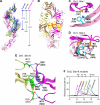Molecular basis of Wnt activation via the DIX domain protein Ccd1
- PMID: 21189423
- PMCID: PMC3048742
- DOI: 10.1074/jbc.M110.186742
Molecular basis of Wnt activation via the DIX domain protein Ccd1
Abstract
The Wnt signaling plays pivotal roles in embryogenesis and cancer, and the three DIX domain-containing proteins, Dvl, Axin, and Ccd1, play distinct roles in the initiation and regulation of canonical Wnt signaling. Overexpressed Dvl has a tendency to form large polymers in a cytoplasmic punctate pattern, whereas the biologically active Dvl in fact forms low molecular weight oligomers. The molecular basis for how the polymeric sizes of Dvl proteins are controlled upon Wnt signaling remains unclear. Here we show that Ccd1 up-regulates canonical Wnt signaling via acting synergistically with Dvl. We determined the crystal structures of wild type Ccd1-DIX and mutant Dvl1-DIX(Y17D), which pack into "head-to-tail" helical filaments. Structural analyses reveal two sites crucial for intra-filament homo- and hetero-interaction and a third site for inter-filament homo-assembly. Systematic mutagenesis studies identified critical residues from all three sites required for Dvl homo-oligomerization, puncta formation, and stimulation of Wnt signaling. Remarkably, Ccd1 forms a hetero-complex with Dvl through the "head" of Dvl-DIX and the "tail" of Ccd1-DIX, depolymerizes Dvl homo-assembly, and thereby controls the size of Dvl polymer. These data together suggest a molecular mechanism for Ccd1-mediated Wnt activation in that Ccd1 converts latent polymeric Dvl to a biologically active oligomer(s).
Figures







Similar articles
-
Structural basis for Ccd1 auto-inhibition in the Wnt pathway through homomerization of the DIX domain.Sci Rep. 2017 Aug 10;7(1):7739. doi: 10.1038/s41598-017-08019-5. Sci Rep. 2017. PMID: 28798413 Free PMC article.
-
The DIX domain protein coiled-coil-DIX1 inhibits c-Jun N-terminal kinase activation by Axin and dishevelled through distinct mechanisms.J Biol Chem. 2004 Sep 17;279(38):39366-73. doi: 10.1074/jbc.M404598200. Epub 2004 Jul 15. J Biol Chem. 2004. PMID: 15262978
-
Identification and differential expression of multiple isoforms of mouse Coiled-coil-DIX1 (Ccd1), a positive regulator of Wnt signaling.Brain Res Mol Brain Res. 2005 Apr 27;135(1-2):169-80. doi: 10.1016/j.molbrainres.2004.12.002. Epub 2005 Jan 27. Brain Res Mol Brain Res. 2005. PMID: 15857680
-
The cellular story of dishevelleds.Croat Med J. 2014 Oct;55(5):459-67. doi: 10.3325/cmj.2014.55.459. Croat Med J. 2014. PMID: 25358879 Free PMC article. Review.
-
Runnin' with the Dvl: proteins that associate with Dsh/Dvl and their significance to Wnt signal transduction.Dev Biol. 2003 Jan 1;253(1):1-17. doi: 10.1006/dbio.2002.0869. Dev Biol. 2003. PMID: 12490194 Review.
Cited by
-
An NKX2-1/ERK/WNT feedback loop modulates gastric identity and response to targeted therapy in lung adenocarcinoma.Elife. 2021 Apr 6;10:e66788. doi: 10.7554/eLife.66788. Elife. 2021. PMID: 33821796 Free PMC article.
-
The β-catenin destruction complex.Cold Spring Harb Perspect Biol. 2013 Jan 1;5(1):a007898. doi: 10.1101/cshperspect.a007898. Cold Spring Harb Perspect Biol. 2013. PMID: 23169527 Free PMC article. Review.
-
Structural basis for Ccd1 auto-inhibition in the Wnt pathway through homomerization of the DIX domain.Sci Rep. 2017 Aug 10;7(1):7739. doi: 10.1038/s41598-017-08019-5. Sci Rep. 2017. PMID: 28798413 Free PMC article.
-
Limited dishevelled/Axin oligomerization determines efficiency of Wnt/β-catenin signal transduction.Elife. 2020 Apr 16;9:e55015. doi: 10.7554/eLife.55015. Elife. 2020. PMID: 32297861 Free PMC article.
-
A direct heterotypic interaction between the DIX domains of Dishevelled and Axin mediates signaling to β-catenin.Sci Signal. 2019 Dec 10;12(611):eaaw5505. doi: 10.1126/scisignal.aaw5505. Sci Signal. 2019. PMID: 31822591 Free PMC article.
References
-
- Logan C. Y., Nusse R. (2004) Annu. Rev. Cell Dev. Biol. 20, 781–810 - PubMed
-
- Clevers H. (2006) Cell 127, 469–480 - PubMed
-
- Klaus A., Birchmeier W. (2008) Nat. Rev. Cancer 8, 387–398 - PubMed
-
- Cadigan K. M., Nusse R. (1997) Genes Dev. 11, 3286–3305 - PubMed
-
- Schwarz-Romond T., Fiedler M., Shibata N., Butler P. J., Kikuchi A., Higuchi Y., Bienz M. (2007) Nat. Struct. Mol. Biol. 14, 484–492 - PubMed
Publication types
MeSH terms
Substances
Associated data
- Actions
- Actions
LinkOut - more resources
Full Text Sources
Molecular Biology Databases

